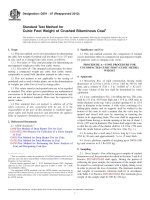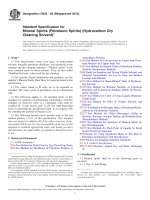Astm d 704 99 (2012)
Bạn đang xem bản rút gọn của tài liệu. Xem và tải ngay bản đầy đủ của tài liệu tại đây (80.46 KB, 3 trang )
Designation: D704 − 99 (Reapproved 2012)
Standard Specification for
Melamine-Formaldehyde Molding Compounds1
This standard is issued under the fixed designation D704; the number immediately following the designation indicates the year of
original adoption or, in the case of revision, the year of last revision. A number in parentheses indicates the year of last reapproval. A
superscript epsilon (´) indicates an editorial change since the last revision or reapproval.
This standard has been approved for use by agencies of the Department of Defense.
D731 Test Method for Molding Index of Thermosetting
Molding Powder
D790 Test Methods for Flexural Properties of Unreinforced
and Reinforced Plastics and Electrical Insulating Materials
D792 Test Methods for Density and Specific Gravity (Relative Density) of Plastics by Displacement
D883 Terminology Relating to Plastics
D1895 Test Methods for Apparent Density, Bulk Factor, and
Pourability of Plastic Materials
D1896 Practice for Transfer Molding Test Specimens of
Thermosetting Compounds
D3638 Test Method for Comparative Tracking Index of
Electrical Insulating Materials
D3795 Test Method for Thermal Flow, Cure, and Behavior
Properties of Pourable Thermosetting Materials by Torque
Rheometer
D3892 Practice for Packaging/Packing of Plastics
D5224 Practice for Compression Molding Test Specimens of
Thermosetting Molding Compounds
D6289 Test Method for Measuring Shrinkage from Mold
Dimensions of Molded Thermosetting Plastics
2.2 ASTM Manual:
Manual 7 Manual on Presentation of Data and Control Chart
Analysis, 8th Edition3
2.3 ISO Standard:
ISO 2122-1977(E) Plastics—Aminoplastic Molding
Materials—Specification4
1. Scope*
1.1 This specification covers compression molding,
thermosetting, melamine-formaldehyde molding compounds
as further defined in 4.1, resin binder, with or without other
resins, intimately combined with fillers, pigments, and any
chemical agents needed.
1.2 The values stated in SI units are to be regarded as the
standard.
NOTE 1—The properties included in this specification are those required
to identify the types of molding compounds covered. There may be other
requirements necessary to identify particular characteristics. These will be
added to the specification as their inclusion becomes generally desirable
and the necessary test data and methods become available. Transfer or
injection molding will usually result in different physical and electrical
characteristics than compression molding.
NOTE 2—ISO 2122-1977(E) is similar but not equivalent to this
specification. Product classification and characterization are not equivalent.
2. Referenced Documents
2.1 ASTM Standards:2
D149 Test Method for Dielectric Breakdown Voltage and
Dielectric Strength of Solid Electrical Insulating Materials
at Commercial Power Frequencies
D150 Test Methods for AC Loss Characteristics and Permittivity (Dielectric Constant) of Solid Electrical Insulation
D256 Test Methods for Determining the Izod Pendulum
Impact Resistance of Plastics
D495 Test Method for High-Voltage, Low-Current, Dry Arc
Resistance of Solid Electrical Insulation
D570 Test Method for Water Absorption of Plastics
D618 Practice for Conditioning Plastics for Testing
D648 Test Method for Deflection Temperature of Plastics
Under Flexural Load in the Edgewise Position
3. Terminology
3.1 Definitions—For definitions of technical terms pertaining to plastics used in this specification see Terminology D883.
4. Classification
1
This specification is under the jurisdiction of ASTM Committee D20 on
Plastics and is the direct responsibility of Subcommittee D20.16 on Thermosetting
Materials.
Current edition approved Dec. 1, 2012. Published December 2012. Originally
approved in 1943. Last previous edition approved in 2004 as D704 - 99(2004). DOI:
10.1520/D0704-99R12.
2
For referenced ASTM standards, visit the ASTM website, www.astm.org, or
contact ASTM Customer Service at For Annual Book of ASTM
Standards volume information, refer to the standard’s Document Summary page on
the ASTM website.
4.1 The molding compounds covered by this specification
shall be designated by types, based upon their principal
characteristics and the fillers used.
3
Available from ASTM International Headquarters. Request MNL7–8TH.
Available from American National Standards Institute (ANSI), 25 W. 43rd St.,
4th Floor, New York, NY 10036, .
4
*A Summary of Changes section appears at the end of this standard
Copyright © ASTM International, 100 Barr Harbor Drive, PO Box C700, West Conshohocken, PA 19428-2959. United States
1
D704 − 99 (2012)
6.2 The required plasticity shall be agreed upon between the
purchaser and producer or supplier. Test Methods D731 and
D3795 are suggested for measuring plasticity and rate of cure.
4.1.1 Type 1—General-purpose compound with cellulose
filler, available in colors, white, and black. Suitable for general,
mechanical, and electrical applications.
4.1.2 Type 2—A mineral- and flock-filled compound for
industrial uses involving elevated-temperature and electrical
applications.
4.1.3 Type 3—A compound with chopped cotton-cloth filler,
having greater impact strength than the other Types 1 through
7.
4.1.4 Type 5—Unreinforced molding compound with high
translucency, particularly suited for small pearlescent moldings.
4.1.5 Type 6—A wood-filled compound for general industrial uses involving mechanical and electric applications.
4.1.6 Type 7—Similar to Type 6, but with cellulose filler and
improved insert-holding properties.
4.1.7 Type 8—A glass-fiber-reinforced compound with high
impact strength and good electrical properties.
4.1.8 Type 9—Short-fiber, glass-filled compound with good
dimensional stability and mechanical properties.
4.1.9 Type 10—A glass fiber-filled compound, with medium
impact strength.
4.1.10 Type 11—A glass-filled, chopped strand compound
with extremely high impact strength and good arc resistance.
4.1.11 Type 12—A fabric-filled compound with medium
impact strength.
6.3 The requirements in Table 1 shall be considered as
minimum or maximum average values. Individual test results
may vary 610 % from the average, in most cases (Note 5). In
the case of arc resistance, all test results must be averaged,
when practicable, and the range of test results must always be
reported. For all other tests, a single result beyond the range of
four times the estimated standard deviation must be discarded,
retests made, and the resulting value substituted for the
discarded value (Note 6).
NOTE 5—The moisture content of the molding compound and the
molded part, as well as mold design, molding process, and molding
conditions, also influence test results.
NOTE 6—A method for determining 99 % confidence limits is given in
Manual 7.
7. Sampling
7.1 A batch or lot shall be considered as a unit of manufacture and may consist of a blend of two or more production runs
of compound.
7.2 Adequate statistical sampling shall be used.
8. Test Specimen Preparation
NOTE 3—Melamine molding compounds are of a limited storage
stability. Melamine resins advance rapidly when stored at elevated
temperatures.
8.1 Where molded specimens are required, Practice D5224
shall be followed as applicable (Note 7). Molds shall be
constructed in accordance with Practice D1896.
5. Ordering Information
NOTE 7—Some melamine compounds may not feed, plasticize, or mold
satisfactorily at the designated temperatures of Practice D5224. In such
cases the recommendation of the manufacturer shall be followed.
5.1 The order for the compound shall specify name, type,
color, and plasticity.
NOTE 4—Compounds with a higher bulk factor than specified in Table
1 may be available.
9. Conditioning
6. Property Requirements
9.1 Measure the plasticity on compounds in the “as received” condition. However, for referee tests, store and condition the samples as described in Test Method D731.
6.1 The molding compounds covered by this specification,
when molded in accordance with Practice D5224, shall conform to the requirements prescribed in Table 1.
9.2 Condition molded test specimens in accordance with
Procedure B of Practice D618.
TABLE 1 Requirements for Compression-Molded Test SpecimensA
Property
Bulk factor, max
Specific gravity, max
Water absorption, max, weight
gain %
Impact resistance, min, J/m of notch
Flexural strength, min, MPa
Deflection temperature, min, ° C
Dielectric strength, min, S/S, kV/mm
Dissipation factor, max,
1 MHz
Arc resistance, min, s
Shrinkage, max, m/m
CTI, min, V
A
Types
1
2
3
5
6
7
8
9
10
11
12
2.7
1.60
0.40
3.0
1.80
0.25
...
1.60
0.60
...
1.55
0.35
2.9
1.60
0.60
...
1.55
0.60
...
2.00
0.20
4.0
1.90
0.15
5.0
2.20
0.20
10.0
2.00
0.20
14.0
1.55
0.50
13.3
68.9
177
9.8
0.05
16.0
51.0
168
9.8
0.060
29.4
82.7
162.7
3.9
...
7.5
65.5
148.8
...
...
16.0
44.8
166
7.9
0.055
16.0
40.0
166
7.9
...
170.8
68.9
204
6.7
...
32.0
96.5
196
9.45
0.02
48.0
82.7
166
9.06
0.02
1066
137.8
204
...
...
53.3
96.5
202
6.89
0.07
120
0.008
500
180
0.006
...
125
0.005
600
...
0.012
...
180
0.008
400
70
0.008
...
180
0.003
...
180
0.004
...
180
0.003
...
180
0.004
700
140
0.005
...
The values shown herein were obtained under specified conditions. Any other conditions may significantly alter these values.
2
D704 − 99 (2012)
oil between cylindrical brass electrodes 25.4 mm in diameter,
with edges next to specimen rounded to a radius of 3.2 mm and
a length of 25.4 mm. The rate of rise for the short-time test
shall be 0.5 kV/s (Note 8). For the step-by-step test the
increment of voltage increase shall be 2 kV and shall be
applied for a period of 1 min.
9.3 Conduct all testing in the Standard Laboratory Atmosphere as specified in Practice D618, unless otherwise specified
in the referenced test methods or in this specification.
10. Test Methods
10.1 Determine the properties enumerated in this specification in accordance with the following methods:
10.1.1 Bulk Factor—Test Methods D1895, using the appropriate method for the compound involved.
10.1.2 Specific Gravity—Method A of Test Methods D792.
A 3.2 by 51-mm disk is a recommended specimen for compounds containing long-fiber fillers that are subject to resinsqueeze-out and flow under pressure.
10.1.3 Water Absorption—Test Method D570, 24-h immersion procedure.
10.1.4 Impact Resistance (Izod)—Method A of Test Methods D256, using a 12.7 by 12.7 by 63.5-mm bar.
10.1.5 Flexural Strength—Method I, Procedure A of Test
Methods D790, using a 6.4 by 12.7 by 127-mm bar, tested
parallel to molding pressure.
10.1.6 Deflection Temperature—Test Method D648, at a
fiber stress of 1.82 MPa on a 12.7 by 12.7 by 127-mm bar,
loaded perpendicular to molding pressure at a 102-mm span.
10.1.7 Dielectric Strength—Test Methods D149, using
specimens 3.2 by 102 mm or larger, tested under transformer
NOTE 8—The short-time test determines the initial voltage for the
step-by-step test.
10.1.8 Permittivity and Dissipation Factor—Test Method
D150, using a 3.2 by 102-mm specimen for all frequencies up
to and including 1 MHz.
10.1.9 Arc Resistance—Test Method D495, using tungsten
electrodes.
10.1.10 Shrinkage—Test Method D6289.
10.1.11 Comparative Tracking Index (CTI)—Test Method
D3638.
11. Packaging and Package Marking
11.1 All packing, packaging, and marking provisions of
Practice D3892 shall apply to this specification.
12. Keywords
12.1 formaldehyde; melamine-formaldehyde; molding compounds (thermosetting)
SUMMARY OF CHANGES
Committee D20 has identified the location of selected changes to this specification since the last issue,
D704 - 99(2004), that may impact the use of this specification. (December 1, 2012)
(1) Five year review. Reapproval without change.
ASTM International takes no position respecting the validity of any patent rights asserted in connection with any item mentioned
in this standard. Users of this standard are expressly advised that determination of the validity of any such patent rights, and the risk
of infringement of such rights, are entirely their own responsibility.
This standard is subject to revision at any time by the responsible technical committee and must be reviewed every five years and
if not revised, either reapproved or withdrawn. Your comments are invited either for revision of this standard or for additional standards
and should be addressed to ASTM International Headquarters. Your comments will receive careful consideration at a meeting of the
responsible technical committee, which you may attend. If you feel that your comments have not received a fair hearing you should
make your views known to the ASTM Committee on Standards, at the address shown below.
This standard is copyrighted by ASTM International, 100 Barr Harbor Drive, PO Box C700, West Conshohocken, PA 19428-2959,
United States. Individual reprints (single or multiple copies) of this standard may be obtained by contacting ASTM at the above
address or at 610-832-9585 (phone), 610-832-9555 (fax), or (e-mail); or through the ASTM website
(www.astm.org). Permission rights to photocopy the standard may also be secured from the ASTM website (www.astm.org/
COPYRIGHT/).
3









